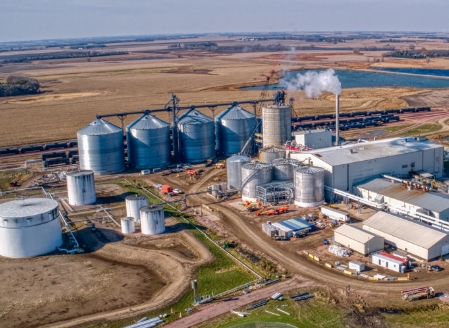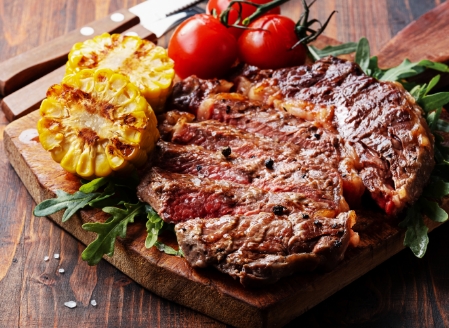Frequently Asked Questions
Ethanol is a renewable fuel. It is typically made from corn, but it's not made from the same type of corn you eat for dinner. Corn used for ethanol production is called yellow dent corn. Ethanol is a cleaner alternative compared to burning gasoline. What makes ethanol cleaner than gasoline? Ethanol is made from a process of refining corn into a liquid. Corn can be grown and harvested every year.
Source: American Coalition for Ethanol
Most ethanol is made from plant starches and sugars—particularly corn starch in the United States. The common method for converting biomass into ethanol is called fermentation. During fermentation, microorganisms (e.g., bacteria and yeast) metabolize plant sugars and produce ethanol.
Source: Department of Energy
Ethanol has less energy density than gasoline but much higher octane values. Therefore if higher blends of ethanol are used in vehicles designed for higher octane then the vehicle is more efficient and there isn’t a mileage penalty. There is very little difference in using E-15 versus E-10 because ethanol seems to combust more completely.
No. The EPA and an academic study have said that fuel containing 15% ethanol is safe for cars, trucks and sport-utility vehicles made in 2001 or later — which make up more than 90% of the vehicles on U.S. roads.
Source: EPA
Source: Academic Study
Most of the gasoline sold in the U.S. contains up to 10% ethanol—the amount varies by region. All automakers approve blends up to E10 in their gasoline vehicles.
Source: Oak Ridge National Laboratory for the U.S. Department of Energy and the U.S. Environmental Protection Agency
Biofuels have been proven to emit significantly lower greenhouse gas (GHG) emissions than petroleum-based fuels, and recent scientific studies indicate that net-zero emission biofuels are not only possible, but achievable.
Source: Energy.gov
The carbon dioxide released by a vehicle when ethanol is burned is offset by the carbon dioxide captured when the feedstock crops are grown to produce ethanol.
Source: U.S. Department of Energy
Ethanol has a proven track record of cutting GHG emissions from transportation.
1. Grain-based ethanol cuts greenhouse gas emissions significantly—by 44 to 52% compared to gasoline, according to the Department of Energy's Argonne National Laboratory. Similarly, researchers from Harvard, MIT, and Tufts concluded that today's corn ethanol offers an average GHG reduction of 46% versus gasoline.
2. A 2022 analysis from a renowned carbon accounting firm finds that the greenhouse gas emissions reductions achieved under the Renewable Fuel Standard far exceed the GHG savings originally projected by EPA. In the 15 years since the RFS was expanded, the use of biofuels under the program has resulted in cumulative savings of more than 1.2 billion metric tons of carbon dioxide-equivalent GHG emissions, with corn ethanol providing the largest share of GHG reductions.
Source: Renewable Fuels Association
Using ethanol as a vehicle fuel has measurable GHG emissions benefits when considering the life cycle steps for required gasoline. By using ethanol blends like E10, motorists can reduce harmful emissions.
Source: U.S. Department of Energy
The use of corn ethanol from 2005 to 2019 has reduced the carbon footprint in the United States and diminished greenhouse gases, according to an Argonne National Labs study. The study, recently published in Biofuels, Bioproducts and Biorefining, analyzes corn ethanol production in the United States from 2005 to 2019, when production more than quadrupled. Scientists assessed corn ethanol’s greenhouse gas (GHG) emission intensity (sometimes known as carbon intensity, or CI) during that period and found a 23% reduction in CI.
Source: Argonne National Laboratory
No. Using corn for ethanol does not have a significant impact on food prices. Critics of biofuels promote a theory that ethanol “eats up” food supplies, but the truth is that the increasing demand for biofuels allows farmers to invest in efficiencies to better utilize existing cropland, allowing them to supply more food and energy. The real driver of food prices is the cost of crude oil. Ethanol production only utilizes the starch in each kernel, while the rest of the fat, fiber and protein goes into animal feed in the form of distillers grains. The reality is that the bioprocessing plant concentrates nutrients into one of Americas largest sources of animal feed.
Source: Growth Energy
Ethanol has a much higher octane rating (about 109) than gasoline. Refiners usually blend ethanol with gasoline to help boost its octane rating—most gasoline in the U.S. contains up to 10% ethanol. Blends of up to 15% ethanol are available in some areas, and several manufacturers approve using this blend in recent-model vehicles.
Source: FuelEconomy.gov
E10 and E15 are blends of ethanol and gasoline. The number after the "E" indicates the percentage of ethanol by volume. Most of the gasoline sold in the U.S. contains up to 10% ethanol—the amount varies by region. All automakers approve blends up to E10 in their gasoline vehicles. As of 2011, EPA began allowing the use of E15 in model year 2001 and newer gasoline vehicles. E85, also called flex fuel, is an ethanol-gasoline blend containing 51% to 83% ethanol, depending on geography and season. Summer blends tend to have more ethanol while winter blends have less.4 E85 can be used in FFVs, which are specially designed to run on gasoline, E85, or any mixture of the two. FFVs are offered by several automakers.
Source: FuelEconomy.gov
Always check your owner’s manual. Some higher blends of ethanol fuel are not approved for motorcycles, off-road vehicles (like snowmobiles and boats), vehicles with heavy-duty engines (such as buses and delivery trucks) or engines in off-road equipment (like lawnmowers and chainsaws).
Source: American Coalition for Ethanol
The most common use of ethanol is as a fuel, which is blended with gasoline. Most of the gasoline sold in the United States contains ethanol. Ethanol adds oxygen to the fuel so the engine burns cleaner, and it increases the octane levels of pure gasoline to improve performance. The amount of ethanol mixed with gasoline may vary by region and season of the year but is usually around 10%. The impact on fuel economy depends on the ethanol content in the fuel and whether an engine is optimized to run on gasoline or ethanol.
Source: Energy.gov
All ethanol is biofuel, but not all biofuels are ethanol. Ethanol is a type of alcohol that can be blended with gasoline and burned in modern engines. While ethanol is typically made from plant matter, biodiesel, another type of biofuel, can be made from vegetable oil, animal fat, and even used restaurant grease. It is not blended with gasoline.
Source: Energy.gov
1. Ethanol is a high-performance fuel the pros trust. Indianapolis 500 drivers often fuel their race cars with E98 because of its high octane.
Source: American Chemical Society
2. Ethanol powers America’s rural economy. According to the Renewable Fuels Association, in 2022, more than 78,800 U.S. jobs were directly associated with the ethanol industry, with an additional 342,800 indirect and induced jobs supported across all sectors of the economy. The industry created $34.8 billion in household income and contributed just over $57 billion to the nation's gross domestic product - the second-highest GDP contribution ever.
Source: Renewable Fuels Association
You can find the E10 ethanol-gasoline blend at nearly all gas stations across the country, and a growing number of retailers are offering E15 and E85. Here’s a great resource to help you find these higher blends: https://e85prices.com/e85map
Source: Renewable Fuels Association
Related EthaKnowledge

Ethanol doesn't harm your car's engine - or your fuel efficiency.
Today’s vehicles are designed to run on gasoline blended with small amounts of ethanol (15% or less) with little effect on fuel economy.
Source: ethanolrfa.org

Ethanol product delivers a net energy gain.
Improved farming techniques, more efficient use of fertilizers and pesticides, higher yielding crops and more efficient conversion technologies have made ethanol a net energy producer. This means the energy content of ethanol is greater than the fossil energy used to produce it. That’s good news for our farmers—and good for the planet.
Source: ethanolrfa.org

Ethanol production is not the driver of food prices.
Critics of biofuels promote a theory that ethanol “eats up” food supplies, but the truth is that the increasing demand for biofuels allows farmers to invest in efficiencies to better utilize existing cropland, allowing them to supply more food and energy. The real driver of food prices is the cost of crude oil. Ethanol production only utilizes the starch in each kernel, while the rest of the fat, fiber and protein goes into animal feed in the form of distillers grains. The reality is that the bioprocessing plant concentrates nutrients into one of Americas largest sources of animal feed.
Source: growthenergy.org
